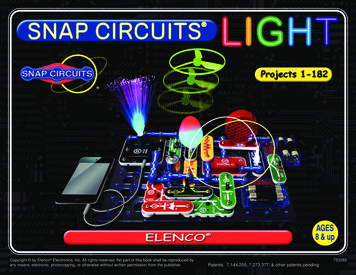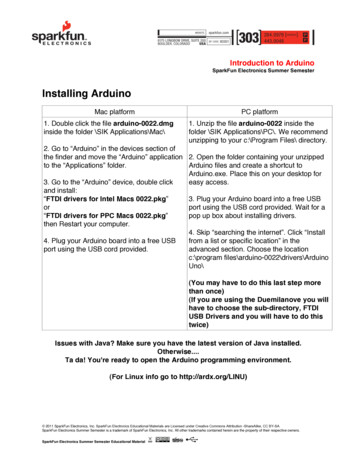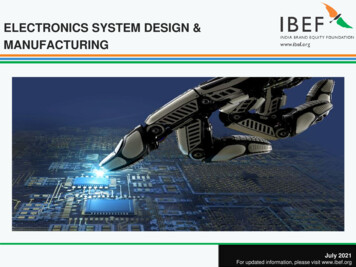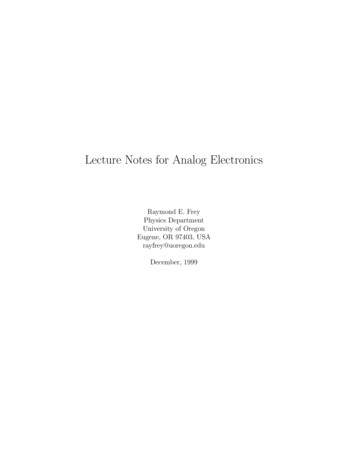
Transcription
Copyright by Elenco Electronics, Inc. All rights reserved. No part of this book shall be reproduced byany means; electronic, photocopying, or otherwise without written permission from the publisher.753285Patents: 7,144,255; 7,273,377; & other patents pending
Table of ContentsBasic TroubleshootingParts ListHow to Use Snap Circuits About Your Snap Circuits LIGHT PartsIntroduction to ElectricityLight in Our World!12, 34, 56-8910-121314, 1516, 1718 - 8182Apple Inc. is not affiliated with nor endorses this product. iPod is a registered trademark of Apple Inc.WARNING FOR ALL PROJECTS WITH A ! SYMBOL - Moving parts. Do not touch the motor or fan during operation.Do not lean over the motor. Do not launch the fan at people, animals, or objects. Eye protection is recommended.WARNING: SHOCK HAZARD - Never connect SnapCircuits to the electrical outlets in your home in any way!Basic Troubleshooting1. Most circuit problems are due to incorrect assembly,always double-check that your circuit exactly matchesthe drawing for it.2. Be sure that parts with positive/negative markings arepositioned as per the drawing.3. Be sure that all connections are securely snapped.4. Try replacing the batteries.5. If the motor spins but does not balance the fan, checkthe black plastic piece with three prongs on the motorshaft, and replace it if it is damaged (this kit includesa spare). To replace, pry the broken one off the motorshaft using a screwdriver, then push the new one on.6. If a fiber optics circuit isn’t working, make sure theclear & black cable holders are pushed all the way ontothe LED/phototransistor, and the fiber optic cable ispushed into the holders as far as it will go. The cableshould be standing straight up in th holders.ELENCO is not responsible for parts damaged due toincorrect wiring.Note: If you suspect you have damaged parts, you can follow theAdvanced Troubleshooting procedure on page 15 to determine which onesneed replacing.-1-DO’s and DON’Ts of Building CircuitsAdvanced TroubleshootingProject ListingsProjects 1 - 182Other Snap Circuits Projects!WARNING: CHOKING HAZARD Small parts. Not for children under 3 years.WARNING: Always check your wiring beforeturning on a circuit. Never leave a circuitunattended while the batteries are installed.Never connect additional batteries or anyother power sources to your circuits. Discardany cracked or broken parts.Adult Supervision:Because children’sabilities vary so much, even with age groups,adults should exercise discretion as to whichexperiments are suitable and safe (theinstructions should enable supervisingadults to establish the experiment’ssuitability for the child). Make sure your childreads and follows all of the relevantinstructions and safety procedures, and!Batteries: Use only 1.5V AA type, alkaline batteries (notincluded). Insert batteries with correct polarity. Non-rechargeable batteries should not berecharged. Rechargeable batteries shouldonly be charged under adult supervision, andshould not be recharged while in the product. Do not mix old and new batteries.!Conforms toASTMF963-96Akeeps them at hand for reference.This product is intended for use by adultsand children who have attained sufficientmaturity to read and follow directions andwarnings.Never modify your parts, as doing so maydisable important safety features in them,and could put your child at risk of injury.CAUTION: Persons who are extremelysensitive to flashing lights and rapidlychanging colors or patterns should exercisecaution when playing with this toy.CAUTION: High intensity light. Do not lookdirectly at white LED (D6). Do not connect batteries or battery holders inparallel. Do not mix alkaline, standard (carbon-zinc),or rechargeable (nickel-cadmium) batteries. Remove batteries when they are used up. Do not short circuit the battery terminals. Never throw batteries in a fire or attempt toopen its outer casing. Batteries are harmful if swallowed, so keepaway from small children.
Parts List (Colors and styles may vary) Symbols and Numbers (page 1)Important: If any parts are missing or damaged, DO NOT RETURN TO RETAILER. Call toll-free (800) 533-2441 or e-mail us at:help@elenco.com. Customer Service 150 Carpenter Ave. Wheeling, IL 60090 U.S.A.Qty.ID 1NameSymbolPart #Qty.IDNameSymbolPart #Base Grid(11.0” x 7.7”)6SCBG 1D6White Light EmittingDiode (LED)6SCD6D8Color Light EmittingDiode (LED)6SCD8 311-Snap Wire6SC01 1 622-Snap Wire6SC02 1Jumper Wire (black)6SCJ1 333-Snap Wire6SC03 1Jumper Wire (red)6SCJ2 144-Snap Wire6SC04 1Motor6SCM1 155-Snap Wire6SC05 1Spare Motor Top6SCM1T 166-Snap Wire6SC06 1Glow Fan Blade6SCM1FG6SCB1 1Disc Holder6SCM1DHSet of Disc Cutouts(6 pcs. / set)6SCM1DSM1 2B1Battery Holder - usestwo (2) 1.5V type “AA”(not Included) 1C20.1µF Capacitor6SCC2 1 1C4100µF Capacitor6SCC4 1Q1PNP Transistor6SCQ1 1D1Red Light EmittingDiode (LED)6SCD1 1Q2NPN Transistor6SCQ2You may order additional / replacement parts at our website: www.snapcircuits.net-2-
Parts List (Colors and styles may vary) Symbols and Numbers (page 2)Important: If any parts are missing or damaged, DO NOT RETURN TO RETAILER. Call toll-free (800) 533-2441 or e-mail us at:help@elenco.com. Customer Service 150 Carpenter Ave. Wheeling, IL 60090 U.S.A.Qty.IDName 1Q4 1Part #Qty.IDNamePhototransistor6SCQ4 1U23Strobe IC6SCU23R1100Ω Resistor6SCR1 1U24Infrared Receiver6SCU24 1R35.1kΩ Resistor6SCR3 1Fiber Optic Cable6SCFC 1R5100kΩ Resistor6SCR5 1Fiber Optic CableHolder, clear6SCFCHC 1RVAdjustable Resistor6SCRV 1Fiber Optic CableHolder, black6SCFCHB 1S1Slide Switch6SCS1 1Fiber Optic Tree 1S2Press Switch6SCS2 1Mounting Base(for fiber optic tree) 1SPSpeaker6SCSP 1Tower LEDAttachment 1X1Microphone6SCX1 1Egg LED Attachment6SCEGG 1U22Color Organ6SCU22 1Prismatic Film6SCFILMStereo Cable9TLSCST 1Red/Green/BlueFilters Set6SCFRGB 1SymbolSymbolYou may order additional / replacement parts at our website: www.snapcircuits.net-3-Part #6SCFT6SCFMB6SCTOWER
How to Use Snap Circuits Snap Circuits uses building blocks with snapsto build the different electrical and electroniccircuits in the projects. Each block has afunction: there are switch blocks, light blocks,battery blocks, different length wire blocks, etc.These blocks are different colors and havenumbers on them so that you can easilyidentify them. The blocks you will be using areshown as color symbols with level numbersnext to them, allowing you to easily snap themtogether to form a circuit.You need a power source to build each circuit.This is labeled B1 and requires two (2) 1.5V“AA” batteries (not included).Usually when the motor M1 is used, the glowfan will usually be placed on it. On top of themotor shaft is a black plastic piece (the motortop) with three little tabs. Lay the fan on theblack piece so the slots in its bottom “fall intoplace” around the three tabs in the motor top.If not placed properly, the fan will fall off whenthe motor starts to spin.For Example:This is the switch block which is green and hasthe marking S2 on it. The part symbols in thisbooklet may not exactly match the appearanceof the actual parts, but will clearly identify them.This is a wire block which is blue and comesin different wire lengths.This one has the number 2 , 3 , 4 , 5 ,or 6 on it depending on the length of the wireconnection required.There is also a 1-snap wire that is used as aspacer or for interconnection between differentlayers.A large clear plastic base grid is included withthis kit to help keep the circuit blocks properlyspaced. You will see evenly spaced posts thatthe different blocks snap into. The base hasrows labeled A-G and columns labeled 1-10.Next to each part in every circuit drawing is asmall number in black. This tells you whichlevel the component is placed at. Place allparts on level 1 first, then all of the parts onlevel 2, then all of the parts on level 3, etc.Some circuits use the jumper wires to makeunusual connections. Just clip them to themetal snaps or as indicated.This set contains 6 pre-punched cardboarddiscs. These will be used with a strobe light inproject 46 and others. The discs may besupplied as a single sheet; just punch themout.To remove a discfrom the holder, useyour fingernail, oruse a pencil to pushit up from beneathone of the tabs.-4-
How to Use Snap Circuits In some projects, the fiber optic cable will bemounted on the LEDs (D1, D6, D8, and onU22) or the phototransistor (Q4). This is doneby placing the clear and black cable holdersonto the LED/phototransistor, then insertingthe fiber optic cable all the way into the holder.For best performance the cable should standstraight up in the holders, without bendingthem. This is described in the projects.This set contains three LED attachments,which can be mounted on the LED modules(D1, D6, D8, and on U22) to enhance theirlight effects. The egg and tower attachmentsare mounted directly on the LEDs, but the fiberoptic tree must be mounted using themounting base, as shown. This is described inthe projects.Egg LED attachmentmounted to D6Black cable holdermounted to Q4Clear cable holdermounted to D1EggLight TowerLED attachmentmounted to D1CorrectFiber Optic TreeLED attachmentmounted to D8IncorrectFiber Optic TreeLED attachmentmounted to U22Fiber Optic Tree-5-Light TowerNote: While building the projects, becareful not to accidentally make a directconnection across the battery holder (a“short circuit”), as this may damage and/orquickly drain the batteries.
About Your Snap Circuits LIGHT Parts(Part designs are subject to change withoutnotice).BASE GRIDThe base grid is a platform for mounting partsand wires. It functions like the printed circuitboards used in most electronic products, or likehow the walls are used for mounting the electricalwiring in your home.BATTERY HOLDERThe batteries (B1) produce an electrical voltageusing a chemical reaction. This “voltage” can bethought of as electrical pressure, pushingelectricity through a circuit just like a pumppushes water through pipes. This voltage is muchlower and much safer than that used in yourhouse wiring. Using more batteries increases the“pressure”, therefore, more electricity flows.Glow-in-the-dark FanHow does electricity turn the shaft in the motor?The answer is magnetism. Electricity is closelyrelated to magnetism, and an electric currentflowing in a wire has a magnetic field similar tothat of a very, very tiny magnet. Inside the motoris a coil of wire with many loops wrapped aroundmetal plates. This is called an electromagnet. Ifa large electric current flows through the loops, itwill turn ordinary metal into a magnet. The motorshell also has a magnet on it. When electricityflows through the electromagnet, it repels fromthe magnet on the motor shell and the shaftspins. If the fan is on the motor shaft, then itsblades will create airflow.SNAP WIRES & JUMPER WIRESThe blue snap wiresare wires used toconnect components.They are used totransport electricity and donot affect circuit performance.They come in different lengths toallow orderly arrangement of connectionson the base grid.The red and blackjumper wires makeflexible connections fortimes when using the snap wireswould be difficult. They also areused to make connections off the base grid.Battery Holder (B1)MOTORThe motor (M1) converts electricity intomechanical motion. An electric current in themotor will turn the shaft and the motor blades,and the fan blade if it is on the motor.Power ContactsMagnetShellShaftWires transport electricity just like pipes are usedto transport water. The colorful plastic coatingprotects them and prevents electricity fromgetting in or out.Motor (M1)Electromagnet-6-
About Your Snap Circuits LIGHT PartsRESISTORSSLIDE & PRESS SWITCHESLEDsResistors “resist” the flow of electricity and areused to control or limit the current in a circuit.Snap Circuits LIGHT includes 100Ω (R1), 5.1kΩ(R3), and 100kΩ (R5) resistors (“k” symbolizes1,000, so R5 is really 100,000Ω). Materials likemetal have very low resistance ( 1Ω), whilematerials like paper, plastic, and air have nearinfinite resistance. Increasing circuit resistancereduces the flow of electricity.The slide & press switches (S1 & S2) connect(pressed or “ON”) or disconnect (not pressed or“OFF”) the wires in a circuit. When ON they have noeffect on circuit performance. Switches turn onelectricity just like a faucet turns on water from a pipe.The red, white, and color LED’s (D1, D6, & D8)are light emitting diodes, and may be thought ofas a special one-way light bulbs. In the “forward”direction, (indicated by the “arrow” in the symbol)electricity flows if the voltage exceeds a turn-onthreshold (about 1.5V for red, about 3.0V forwhite, and in between for other colors);brightness then increases. The color LEDcontains red, green, and blue LEDs, with a microcircuit controlling then. A high current will burnout an LED, so the current must be limited byother components in the circuit. LED’s blockelectricity in the “reverse” direction.Slide & PressSwitches(S1 & S2)SPEAKERResistors (R1, R3, & R5)The adjustable resistor (RV) is a 50kΩ resistorbut with a center tap that can be adjustedbetween 200Ω and 50kΩ.Adjustable Resistor (RV)-7-The speaker (SP) convertselectricity into sound bymaking mechanical vibrations. These vibrationscreate variations in airpressure, which travelacross the room. You“hear” sound whenyour ears feel these airpressure variations.Speaker (SP)MICROPHONEThe microphone (X1) is actually a resistor thatchanges in value when changes in air pressure(sounds) apply pressure to its surface. Itsresistance typically varies between 1kΩ and10kΩ.Microphone (X1)LED’s(D1, D6, & D8)CAPACITORThe 0.1µF and 100µF capacitors (C2 & C4) canstore electrical pressure (voltage) for periods oftime. This storage ability allows them to blockstable voltage signals and pass changing ones.Capacitors are used for filtering and delaycircuits.Capacitors(C2 & C4)
About Your Snap Circuits LIGHT PartsTRANSISTORSThe PNP & NPN transistors (Q1 & Q2) arecomponents that use a small electric current tocontrol a large current, and are used in switching,amplifier, and buffering applications. They areeasy to miniaturize, and are the main buildingblocks of integrated circuits including themicroprocessor and memory circuits incomputers.The color organ (U22) contains resistors, capacitors,transistors, a tri-color LED, and integrated circuits. TheLED in it can change colors by direct control, or in synchwith an audio input signal. A schematic for it is available ns:R - red color controlG - green color controlB - blue color control( ) ( ) - power from batteriesINP - circuit inputFB - feedback connection(–) - power return to batteriesIN - audio input jackINPOUT - audio output jackThe LED attachments can be used withany of the LEDs (red, white, color, andthe color organ) to enhance the lighteffects.BSee projects 5, 6, 33, and 34 forexamples of proper connections.Fiber Optic TreeEggLightTowerThe fiber optic cable carries lightbetween two places. The light can beencoded to transmit information. Theclear and black holders are used toattach it to circuits.PNP & NPN Transistors (Q1 & Q2)The phototransistor (Q4) is a transistor thatuses light to control electric current.The strobe IC (U23) contains resistors, capacitors, andtransistors that are needed to make a strobe light circuit.A schematic for it is available at www.snapcircuits.net/faq.( )CTLPhototransistor (Q4)ELECTRONIC MODULESThe Infrared module (U24) is a miniaturizedinfrared receiver circuit for remote control.(–)NCOUTConnections:( ) - power from batteries(–) - power return to batteriesOUT - output connectionCTL - strobe speed controlNC - not usedThe stereo cable is used to connectyour music device to the color organ(U22).See project 46 for example ofproper connections.OTHER PARTSThe disc holder and discs produce amazing effects whenused with the Strobe Effects circuit (project 46).Prismatic film separates light intodifferent colors. The red, green, & bluefilters filter out colors.Infrared module (U24)-8-
Introduction to ElectricityWhat is electricity? Nobody really knows. We only know how to produce it,understand its properties, and how to control it. Electricity is the movement of subatomic charged particles (called electrons) through a material due to electricalpressure across the material, such as from a battery.There are two ways of arranging parts in a circuit, in series orin parallel. Here are examples:Power sources, such as batteries, push electricity through a circuit, like a pumppushes water through pipes. Wires carry electricity, like pipes carry water. Deviceslike LEDs, motors, and speakers use the energy in electricity to do things. Switchesand transistors control the flow of electricity like valves and faucets control water.Resistors limit the flow of electricity.The electrical pressure exerted by a battery or other power source is calledvoltage and is measured in volts (V). Notice the “ ” and “–” signs on the battery;these indicate which direction the battery will “pump” the electricity.Series CircuitThe electric current is a measure of how fast electricity is flowing in a wire, justas the water current describes how fast water is flowing in a pipe. It is expressedin amperes (A) or milliamps (mA, 1/1000 of an ampere).The “power” of electricity is a measure of how fast energy is moving through awire. It is a combination of the voltage and current (Power Voltage x Current). Itis expressed in watts (W).The resistance of a component or circuit represents how much it resists theelectrical pressure (voltage) and limits the flow of electric current. The relationshipis Voltage Current x Resistance. When the resistance increases, less currentflows. Resistance is measured in ohms (Ω), or kilo ohms (kΩ, 1000 ohms).Nearly all of the electricity used in our world is produced at enormous generatorsdriven by steam or water pressure. Wires are used to efficiently transport thisenergy to homes and businesses where it is used. Motors convert the electricityback into mechanical form to drive machinery and appliances. The most importantaspect of electricity in our society is that it allows energy to be easily transportedover distances.Note that “distances” includes not just large distances but also tiny distances. Tryto imagine a plumbing structure of the same complexity as the circuitry inside aportable radio - it would have to be large because we can’t make water pipes sosmall. Electricity allows complex designs to be made very small.-9-Parallel CircuitPlacing components in series increases the resistance; highestvalue dominates. Placing components in parallel decreases theresistance; lower value dominates.The parts within these series and parallel sub-circuits may bearranged in different ways without changing what the circuitdoes. Large circuits are made of combinations of smaller seriesand parallel circuits.
Light in Our WorldWhat would our world be like without light?Moving and doing things in total darknesswould be much more difficult, becauseeveryone would be blind. Plants rely onsunlight for energy and would die without it. Ifall the plants die, then people and animalswould have nothing to eat, and would starve.Let’s hope we never have to live in a worldwithout light.Light is energy, traveling at high speed.Sunlight can warm up your skin, as can brightlights in a concert hall or playhouse. Light cancarry information. For example, our brainsanalyze the light received in our eyes, to learnwhat is around us. In fiber optic cables, beamsof light carry data between cities. Infrared lightfrom a remote control can tell a TV to changeto a different channel.You “see” when light enters your eyes. Whenyou turn on a light in a room, the light shineson everything around it. When light shines onsomething, some of the light is absorbed intoit, and the rest is reflected off. The absorbedlight is converted to heat, and the reflectedlight is scattered around the room. Some of theshining and reflected light might reach youreyes. Your brain interprets the light into youreyes, and makes the mental picture you see.White light beamMental pictureLight moves as super-tiny charges, which areso full of energy they go flying off in alldirections.This happens when a material has too muchenergy, and some of the energy changes form.For example, a light bulb makes light when anelectric current makes the filament so hot thatit glows. Some of the energy in a burning fireescapes by changing to light. Our bright sunmakes so much light because it is basically agigantic ball of thermonuclear reactions. Lightemitting diodes (LEDs) make light byconverting excess electrical energy.Light bulbfilamentGlowinglight bulbfilamentClose-upview of theSunGlowingwhite LED(D6)Reflected lightWhen all the light shining on something isabsorbed, with none reflected towards youreyes, then you can’t see it. The object willappear dark. The brighter an object appears,the more light was reflected off it and into youreyes. Some materials, like air and clear glass,let light pass through them.You can only see themoon when light from thesun bounces off it, andreflects to earth.You can’t see a beam of light traveling acrossa room, unless something scatters the lightand some reaches your eyes. In a dusty room,sometimes you can see the dust particlesfloating in the air when sunlight hits them.In this photograph,sandhasbeentossed into the air,which is illuminatedby a narrow beam ofsunlight coming downinto the canyon.When you turn on alight, you instantlysee everything. Thishappensbecauselight is very fast, andtravels about 186,000miles a second in air.Light rays can bend when they pass betweendifferent materials, such as air and water. Lightbends because its speed changes. The speedof light in water is only about 125,000 miles asecond.The part of the pen in waterlooks distorted, because lightchanges speed when enteringand leaving the water.When you look directly out aglass window, you can seeclearly through it. When youlook through the window at awide angle, you can seethrough it, but also see a reflection in it. Whenyou try to look through the window at a reallywide angle, you can’t see through it at all, andonly see reflections. Try looking through awindow in your home at really wide angles.-10-
Light in Our WorldWhen light hits a glass surface at a wideenough angle, all the light is reflected. Fiberoptic cables have arrays of flexible glass fibers.In these cables, light rays move through bybouncing along the inside walls at wide angles,and can travel great distances. Light movesthrough the cable even if it is bent a little, but ifthere is a tight bend then most of the light willbe absorbed instead of reflected forward.Translucent materials, such as the tower andegg LED attachments in this set, allow somelight to pass through but scatter it around.Any color of light can be made, by mixingdifferent amounts of red, green, and blue light.Mixing equal amounts of these colorsproduces white light. If you look at a TV screenwith a magnifying glass, you will see it actuallyconsists of tiny red, green, and blue lights,using different intensities to make all thecolors.White light beamOrangeOrange reflected lightCable slightly bentCable withtight bendLight beam(full strength)Weak light beamColorThe things around you have different colorsbecause they reflect the colors that you see,while absorbing the other colors. Lightproduced by the sun or a light bulb is calledwhite light. White light is not really a color itself,but is a mixture of all the colors seen in arainbow.White light shines on an orange. All colors inthe light are absorbed except orange, which isreflected off. The reflected orange lightreaches our eyes, so we see it as havingorange color.-11-This set includes several LEDs (D1, D6, D8,and in U22) with different colors. The coloremitted by an LED depends on the materialused in it. LEDs are more energy-efficient thanincandescent light bulbs, can be made smaller,and last longer.White light can be split up into its differentcolors. This happens when light passesbetween different materials, and the differentcolors in it are bent by different amounts. Youcan see this by viewing white light throughprismatic film, as you do in project 67.Sometimes water in the air can bend sunlightby just the right amounts, and make a rainbow.The LED in the color organ module (U22)contains separate red, green, and blue LEDs.The color organ can combine these colors tomake yellow, cyan, purple, and white, asshown in project 6. The color organ does notallow you to adjust the amount of each color.In project 49, several colors are mixed togetheron a spinning disc.Color filters allow one color to pass through,and absorb the other colors. When you lookthrough a red filter, everything looks red (orblack, if there isn’t any red in what you arelooking at). This set includes red, green, andblue filters, so try looking through them.RedMagentaWhite light beamRed light beamRed filterYellowWhiteBlueGreenCyan
Light in Our WorldThe Spectrum of LightInfraredThe light our eyes see is only part of what is around us. Visible light,infrared light, radio waves (including TV broadcasting and cell phones),microwaves, and x-rays are all forms of electromagnetic radiation. Theyare actually changing electric and magnetic fields. This radiation travelslike waves in water, spreading out from where it was created. Thesewaves all travel at the speed of light, but some are longer (higherwavelength) and some repeat faster (higher frequency). Together theyare called the electromagnetic spectrum:Infrared light is invisible light given off byanything warm. Infrared is used in remotecontrols to control TVs and appliances.Infrared is invisible, so it doesn’t disruptyour view of the TV. Infrared doesn’t gothrough walls, so it doesn’t interfere withdevices in other rooms.The visible colors (red, orange, yellow, green, blue, and violet) havedifferent wavelengths. In the right conditions white light from the sun canbe separated according to wavelength, producing a rainbow of color. Thishappens with an actual rainbow, and with prismatic film.Infrared has other uses such as night visiondevices help to see people and animals inthe dark, by looking at the heat they give offas infrared light. You probably saw this in themovies.Why is the sky blue? Some sunlight is scattered by tiny particles in theearth’s atmosphere. The shorter wavelength blue light is scattered morethan the other colors, so the sky appears blue. At sunrise or sunset,longer wavelengthcolors like red oryellow are morevisible in the sky,becausesunlightpasses through moreof the atmospherebefore reaching youreyes. In space, thesky always appearsblack because thereis no atmosphere orscattering effect.The remote control sends a stream ofinfrared light pulses to the TV, encoded withthe desired commands. The infrared light iscreated using an infrared light emittingdiode (LED). Infrared detectors convert thereceived light to electric current, anddecode the commands. The detectors aretuned to focus on the infrared light, andignore visible light. This set contains aninfrared detector (U24), which can beactivated by a TV remote control; seeprojects 41 and 42 for examples.Glow-in-the-darkSome materials can absorb light, store it for a while, and slowly releaseit back out. “Glow-in-the-dark” materials can be “charged” by bright light,then will slowly emit light and “glow” for a while in a dark room. The glowfan blade in this set has a glow powder mixed in the plastic.It’s like a slow, delayed reflection of the light.SoundSound, like light, spreads out like waves from where it was made. Soundis variations in air pressure. You “hear” sound when your ears feel theseair pressure variations. Sound has much longer wavelength than light,which enables sound to travel around corners. Sound can also bethought of as a wave of vibration, and can travel through water and solidobjects. Sound travels about 1,000 feet per second in air, and about5,000 feet per second in water.-12-
DO’s and DON’Ts of Building CircuitsAfter building the circuits given in this booklet, you may wish to experiment on your own.Use the projects in this booklet as a guide, as many important design concepts areintroduced throughout them. Every circuit will include a power source (the batteries), aresistance (which might be a resistor, capacitor, motor, integrated circuit, etc.), and wiringpaths between them and back. You must be careful not to create “short circuits” (very lowresistance paths across the batteries, see examples at right) as this will damagecomponents and/or quickly drain your batteries. Only connect the color organ (U22), strobeIC (U23) and infrared module (U24) using configurations given in the projects, incorrectlydoing so may damage them. ELENCO is not responsible for parts damaged due toincorrect wiring.Here are some important guidelines:ALWAYSUSE EYE PROTECTION WHEN EXPERIMENTING ON YOUR OWN.ALWAYSinclude at least one component that will limit the current through a circuit, suchas the speaker, capacitors, ICs (which must be connected properly), motor,microphone, phototransistor, or resistors.ALWAYSuse LEDs, transistors, and switches in conjunction with other components thatwill limit the current through them. Failure to do so will create a short circuitand/or damage those parts.ALWAYSconnect capacitors so that the “ ” side gets the higher voltage.ALWAYSdisconnect your batteries immediately and check your wiring if somethingappears to be getting hot.ALWAYScheck your wiring before turning on a circuit.ALWAYSconnect the color organ (U22), strobe IC (U23) and infrared module (U24)using configurations given in the projects or as per the connection descriptionon page 8.NEVERconnect to an electrical outlet in your home in any way.NEVERleave a circuit unattended when it is turned on.NEVERtouch the motor when it is spinning at high sp
White Light Emitting Diode (LED) 6SCD6 1-Snap Wire 3 6SC01 6SCD8 1 Color Light Emitting Diode (LED) 6 2-Snap Wire 6SC02 1 Jumper Wire (black) 6SCJ1 Jumper Wire (red) 3 3-Snap Wire 6SC03 1 6SCJ2 4-Snap Wire 1 6SC04 1 Motor 6SCM1 5-Snap Wire 1 6SC05 Spare Motor






![History of Electronics electricity [Read-Only]](/img/18/history-20of-20electronics-20-20electricity.jpg)



